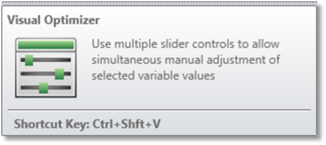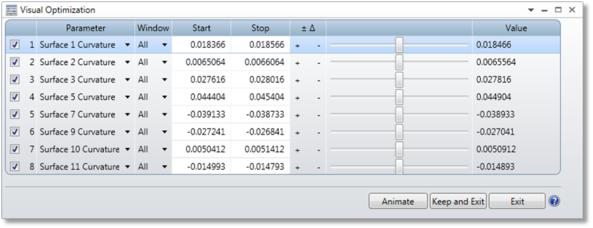Visual Optimizer


The Visual Optimizer is available in the Manual Adjustment section of the Optimize tab. This feature uses multiple slider controls to allow simultaneous manual adjustment of selected variable values.

Settings:
Parameter Selects the parameter for that slider to control
Window Select either "All" or any specific analysis window to update when the slider is adjusted. See the discussion.
Start/Stop The minimum and maximum values of the variable, corresponding to the full left and right positions of the slider control, respectively. The difference between the max and min values is the total range of the slider.
Slider The slider control, which may be dragged left or right to adjust the selected variable.
Value The current value of the variable for reference.
Animate / Stop Automatically increments the data over the defined range, and updates the selected windows in a continuous loop. Press "Stop" (the animate button changes to a "Stop" when animation is running) to terminate the animation.
Keep and Exit Saves the current value in the editor and closes the Visual Optimization control.
Exit Restores the original data for the modified parameter and closes the Visual Optimization control.
Discussion:
The visual optimization dialog supports between 1 and 8 individual slider controls. Each slider control may be used to interactively modify any defined variable value. Note the variable status of each value must be set prior to invoking the visual optimization control.
Whenever any variable value is changed, the selected window or all windows are updated in sequential mode. In non-sequential mode, the rays optionally may be traced to update all detector viewers and (optionally) shaded model plots. These operations take time, depending upon the system complexity, the types of analysis windows open, and the number of rays traced. The visual optimization tool will not allow another update to be performed until the current update is completed. It may be required to wait until the updates are completed before the slider may be adjusted again. However, for many illumination systems LightningTrace is fast enough that updates occur almost instantaneously, allowing the performance impact of changing a variable value to be determined in real-time.
Note that radius variables are always varied as curvatures as opposed to radii for numerical stability. The same applies to focal length variables, which are varied as power. This is indicated with the correct labels in the visual optimizer.
Next:


